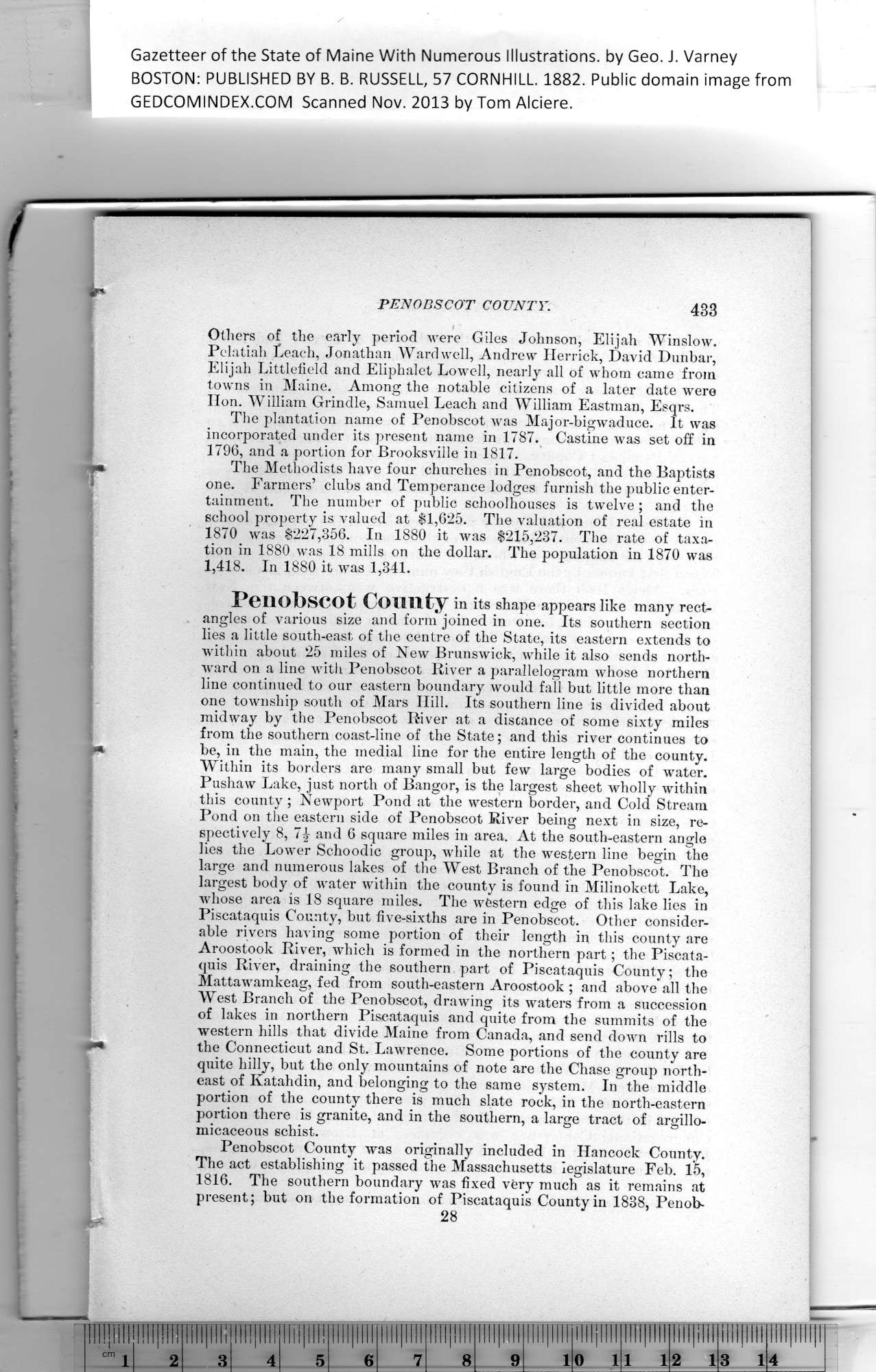|
Gazetteer of the State of Maine With Numerous Illustrations, by Geo. J. Varney
BOSTON: PUBLISHED BY B. B. RUSSELL, 57 CORNHILL. 1882. Public domain image from
PENOBSCOT COvNTT 433
Others of the early period were Giles Johnson, Elijah Winslow.
Pelatiah fieach, Jonathan Ward well, Andrew Herrick, David Dunbar,
Elijah Littlefield and Eliphalet Lowell, nearly all of whom came from
towns in Maine. Among the notable citizens of a later date were
Hon. William Grindle, Samuel Leach and William Eastman, Esqrs.
The plantation name of Penobscot was Major-bigwaduce. It was
incorporated under its present name in 1787. Castine was set off in
1796, and a portion for Brooksville in 1817.
The Methodists have four churches in Penobscot, and the Baptists
one. Farmers’ clubs and Temperance lodges furnish the public enter-
tainment. The number of public schoolhouses is twelve ; and the
school property is valued at $1,625. The valuation of real estate in
1870 was $227,356. In 1880 it was $215,237. The rate of taxa-
tion in 1880 was 18 mills on the dollar. The population in 1870 was
1,418. In 1880 it was 1,341.
Penobscot County in its shape appears like many rect-
angles of various size and form joined in one. Its southern section
lies a little south-east of the centre of the State, its eastern extends to
within about 25 miles of New Brunswick, while it also sends north-
ward on a line with Penobscot River a parallelogram whose northern
line continued to our eastern boundary would fall but little more than
one township south of Mars Hill. Its southern line is divided about
midway by the Penobscot River at a distance of some sixty miles
from the southern coast-line of the State; and this river continues to
be, in the main, the medial line for the entire length of the county.
Within its borders are many small but few large bodies of water.
Pushaw Lake, just north of Bangor, is the largest sheet wholly within
this county ; Newport Pond at the western border, and Cold Stream
Pond on the eastern side of Penobscot River being next in size, re-
spectively 8, 7% and 6 square miles in area. At the south-eastern angle
lies the Lower Schoodic group, while at the western line begin the
large and numerous lakes of the West Branch of the Penobscot. The
largest body of water within the county is found in Milinokett Lake,
whose area is 18 square miles. The western edge of this lake lies in
Piscataquis County, but five-sixths are in Penobscot. Other consider-
able rivers having some portion of their length in this county are
Aroostook River, which is formed in the northern part; the Piscata-
quis River, draining the southern part of Piscataquis County; the
Mattawamkeag, fed from south-eastern Aroostook ; and above all the
West Branch of the Penobscot, drawing its waters from a succession
of lakes in northern Piscataquis and quite from the summits of the
western hills that divide Maine from Canada, and send down rills to
the Connecticut and St. Lawrence. Some portions of the county are
\ quite hilly, but the only mountains of note are the Chase group north-
east of Katahdin, and belonging to the same system. In the middle
portion of the county there is much slate rock, in the north-eastern
portion there is granite, and in the southern, a large tract of argillo-
micaceous schist.
Penobscot County was originally included in Hancock County.
The act establishing it passed the Massachusetts legislature Feb. 15,
1816. The southern boundary was fixed very much as it remains at
present; but on the formation of Piscataquis County in 1838, Penob-
28
PREVIOUS PAGE ... NEXT PAGE
This page was written in HTML using a program written in Python 3.2
|
